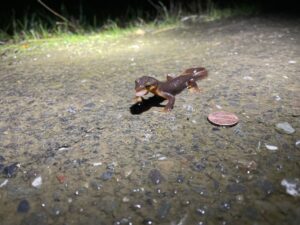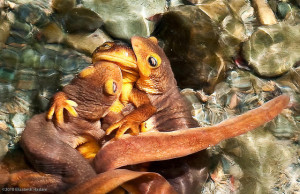After the long dry spell, the onset of rain is bringing the Bay Area back to life. All the puddles and ponds forming here and there are creating mating habitat for California newts, which you can bet have been waiting all season to congregate and let out steam to procreate.
Taricha tarosa spends most of its life in rocks crevices and in logs happily munching invertebrates like earthworms, snails and crickets. But when the heavens fall, as they typically do between December and May, California newts return to their watery birthplace, usually the very same pond, to find their mates.
Videographer Ian Nelson set out recently with his GoPro Hero 3 underwater camera to visit a pond a short distance up from Spring Lake at Annadel State Park in Santa Rosa. He’s been there before, so he knows that’s where to find newts in action. He mounted his camera to a tripod and sank it in the water near the shoreline.
“It’s all guesswork since I don’t have a live monitor with the camera, I just had to point and shoot where I thought framing would be best and of course, with a little luck, I was able to capture some truly amazing moments,” Nelson said.
It took him three days, and this is what he got:
California Newts & Frogs from Ian Nelson on Vimeo.
As you might have guessed, all that gripping and gliding is the newts’ mating dance — called “amplexus.” The female is on the underside, doing all the paddling while the male clings to her underbelly. Apparently he’s able to grip her slippery skin because of the rough patches he grows on the bottoms of his feet in the fall.
Oddly enough, the lovers don’t actually mate in this way. Consider it all foreplay. Instead, after a relaxing period of water play, the male detaches and drops a spermatophore (a mound of gelatinous substance with a sperm capsule on top), and the female retrieves it. They then go their separate ways.
You’ll find the fruits of their labor later if you look closely among the plant roots or rocky crevices in slow-moving water. The clear-white egg masses, which contain between seven and 30 eggs, are thick and gelatinous. The larvae hatch sometime in early to mid summer, depending on the local water temperature.
Alison Hawkes is the online editor at Bay Nature.



